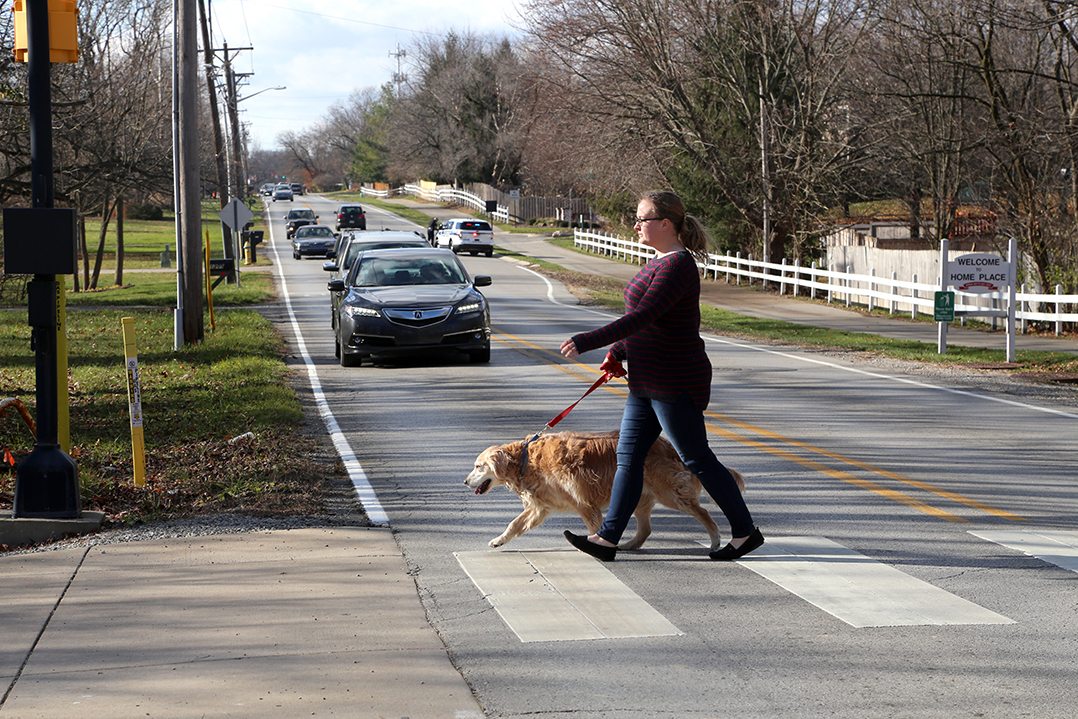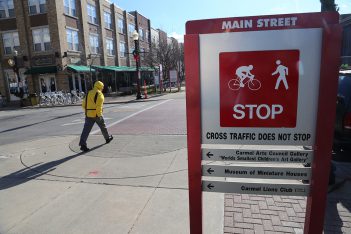
Kathy Horton said it’s a good thing rush hour traffic caused her to drive slowly July 13 along Smokey Row Road. Otherwise, her story might have had a much different ending.
Horton struck a 32-year-old Carmel man who was running along the Monon Trail at the intersection. She said he “came out of nowhere” and rolled onto the hood of her car before hitting the ground.
“If I’d have been going the speed limit, he’d probably be dead,” Horton said. “Even at 30 miles per hour, I can’t imagine the impact it would be on a person. I was not moving quickly at all, and I still sliced the back of his head open.”

The runner did not respond to requests for an interview. His injuries turned out not to be life threatening, which has fortunately been the case for all five pedestrians or bicyclists to be struck at Monon Trail street crossings in 2017. The five incidents are a jump from previous years, with one reported in 2015, two in 2012 and none in 2013, 2014 and 2016, according to Carmel Police Dept. records.
The spike in accidents could be a fluke, as numbers provided by CPD show that Monon Trail usage decreased from 398,280 in 2014 to 303,884 in 2016. The department moved the counter and didn’t begin using it again until early May 2017, but through Dec. 15 it tracked 286,965 people on the trail.
CPD Sgt. Donald Schoeff said the decreasing numbers on the Monon are likely caused by miles of other trails opening in Carmel and neighboring cities. But officials don’t expect the downward trend to continue.
“The anticipated residential and commercial growth in Midtown, City Center, the Proscenium and future developments surrounding the central core of the City of Carmel will no doubt boost the number of people using the Monon Greenway for both recreation and commuting to and from work,” said Dan McFeely, a spokesman for the City of Carmel.
CPD Lt. Joe Bickel said it makes sense that more people on the trail would lead to more accidents.
“When you have a greater amount of people on the Monon each year, there’s a higher risk that somebody might get hit, especially somebody who’s not familiar with the area or doesn’t know the rules of the Monon,” Bickel said.
Horton, a 69-year-old Carmel resident, said that she was following the rules when she struck the pedestrian, and the police report confirmed it. Monon Trail users have stop signs at the intersection but motorists do not, meaning pedestrians are required to stop and look for traffic before stepping into the street.
Indiana law states that pedestrians have the right-of-way once they are in the street, but they may not leave a curb, trail or other place of safety to enter a roadway if they don’t give an approaching vehicle enough time to stop.
“Even with a crosswalk, you can’t just run into the path of a vehicle and think that you have the right of way as a pedestrian or bicyclist,” CPD Lt. Joe Bickel said.
Motorists are required to slow down and stop if a pedestrian is already in the intersection once they reach it, but drivers don’t have to stop to check for pedestrians that might be coming.
“Once (a pedestrian) sees a clear path and starts to walk across the street, a motorist can’t accelerate and try to beat them,” Bickel said. “(Motorists) need to decelerate and brake and allow that person to continue to walk across the street.”
In all but one of the accidents involving a vehicle and pedestrian along the Monon Trail since 2012, only once did police determine the driver caused the accident, according to police reports.
And among the six cyclists and one pedestrian determined to be at fault for accidents at Monon Trail crossings, only one of them received a citation from CPD. Bickel said officers have discretion on whether or not to write tickets. Often, the trauma of being hit by a car will change behavior without adding a citation.
Horton hopes that Monon Trail users and drivers who cross it will learn and follow the law.
“As a motorist, it is really traumatizing to actually have somebody on your hood looking through your windshield at you,” Horton said. “It is a horrible, horrible feeling, so I’d really like no one else to have to do this.”
Insurance issues
Once CPD determined the accident was not her fault, Kathy Horton was surprised when a representative with State Farm, her insurance company, told her not to bother fighting the claim submitted by the runner.
State Farm Media Specialist Missy Dundov declined to discuss specifics of Horton’s case because of privacy laws but said each claim is handled differently.
“Insurance companies (not customers) pay or deny claims based on the underlying claim’s individual merits following a thorough investigation,” Dundov stated in an email. “A police report may factor into that investigation as one component of how a claim is handled, but each claim is handled on an individual basis and there are many elements/factors that go into that decision.”
Michael Niland, director of government affairs and political strategy for the Insurance Institute of Indiana, said it’s not unusual for insurance companies to pay claims even when the insured driver isn’t at fault. Sometimes, he said, it’s to avoid a lawsuit that the company might win but spend more money fighting than if they’d just paid the claim.
“With the kind of society we live in, would you prefer paying out a claim or being tied up in a legal battle for a year or two years where you’re maybe more exposed than you want to be?” Niland said. “The police officer says this person was not at fault, but will a jury see it the same way?”
Niland said insurance companies look at several factors when setting individual rates, including personal accident history and environment.
As for setting general rates in an area, he said insurance companies might take notice if accidents continue to increase on the Monon, but that alone shouldn’t cause premiums to rise for Carmel customers.
“It could be a factor as it’s a very mobile area, but it’s not necessarily a negative factor,” Niland said. “That would be a far less impactful factor compared to crime rates or incidents of car robberies.”


